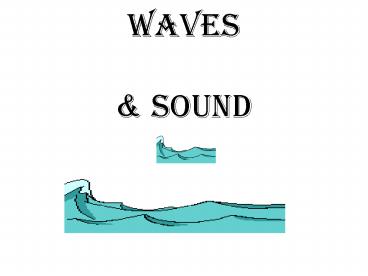Waves - PowerPoint PPT Presentation
1 / 17
Title:
Waves
Description:
Waves & Sound Objectives Describe the measurable properties of waves and explain the relationships among them and how these properties change when the wave moves from ... – PowerPoint PPT presentation
Number of Views:217
Avg rating:3.0/5.0
Title: Waves
1
Waves Sound
2
Objectives
- Describe the measurable properties of waves and
explain the relationships among them and how
these properties change when the wave moves from
one medium to another. - Qualitatively describe the shift in frequency in
sound or electromagnetic waves due to the
relative motion of a source or a receiver.
3
Chapters 2526
- Waves are periodic disturbances that propagate
through a medium or space - a medium does not travel with the wave
- Mechanical waves require a medium
- Electromagnetic waves do not require a medium
4
More on waves
- Longitudinal waves particles of the medium move
parallel to the direction of the wave
Sound is an example of this type of wave.
5
Transverse Waves
- Transverse waves displacement of the particles
of the medium are perpendicular to the direction
of propagation of the wave.
6
Phase of a wave
7
Frequency
8
Properties of Waves
- 1. Rectilinear propagation advancement of a
wave is perpendicular to the wave front - 2. Reflection waves bounce off barriers and
rebound in opposite direction - Law of reflection
- Incident angle reflected angle (i r)
- 3. Refraction bending (changing direction) of a
wave as it travels from one medium into another
9
More properties
- 4. Diffraction spreading of a wave as it passes
beyond the edge of a barrier - http//www.physicsclassroom.com/Class/waves/U10L3b
.html - 5. Interference result of 2 or more waves
passing through the same medium at the same time
http//www.physicsclassroom.com/Class/waves/U10L3c
.html
10
Math associated with waves
- Frequency 1 / Period (f 1/T)
- Period 1 / Freqency
- i.e., f 60cycles per second 60 hz 60/s
- Also v f l
- where velocity frequency x wavelength
11
Sound Waves
12
Math re waves
- I P/A Intensity Power/Area
- Units watt / cm2
- Intensity relates to loudness
You are 1 km away from a radio tower, what is the
intensity of the signal of a 100,000 kw radio
station? 1 km 105 cm 100,000 kw 100,000,000w
108 w I P/A 100,000 kw / 4 p (105)2 7.96 x
10-7 w/cm2
13
More math
- b 10 log I
- Io 10-16 w/cm 2
- b, Intensity level
- I, Intensity
- Io, threshhold of hearing
- We all dont hear the same, so this is a
comparative measurement, in decibels
14
Flow chart for b (intensity) problems
- If I 4.7 x 10-10 w/cm2
- 10xlog(4.7 2nd EE -10 / 1 2nd EE -16) 66.7
dB - If I 2.9 x 10-3 w/cm2
- 10xlog(2.9 2nd EE -3 / 1 2nd EE -16) 135
dB
15
Now we are going backwards from intensity level
(dB) to intensity (w/cm2)
- If the intensity level is 83 dB, convert that to
intensity in w/cm2. - B 10 log I / Io get to a working eqtn
- B /10 log I / Io
- Log-1(B/10) Log-1(log I/Io)
- Log-1(B/10) I/Io
16
More to come
- Doppler Effect is the apparent change in
frequency as a result of relative motion between
the source of a sound and an observer.
F o f s v v o v v
s
fo, frequency heard by observer fs, frequency of
source v, velocity of sound in air vo, velocity
of observer vs, velocity of source
17
More on Doppler
- Stationary observer
- Observer moving away v-vs on bottom
- Observer moving toward vvs on bottom
- Stationary source
- Observer moving toward vvo on top
- Observer moving away v-vo on top































